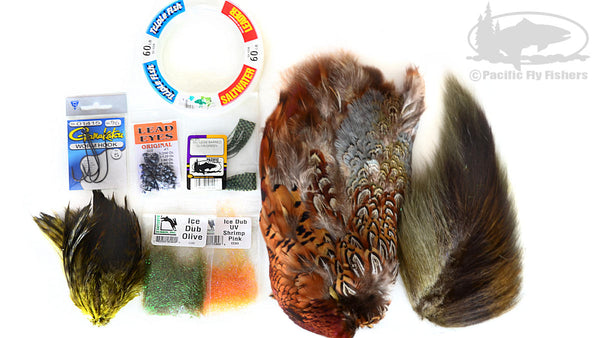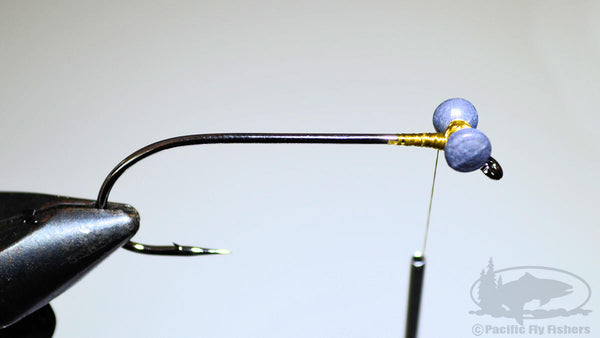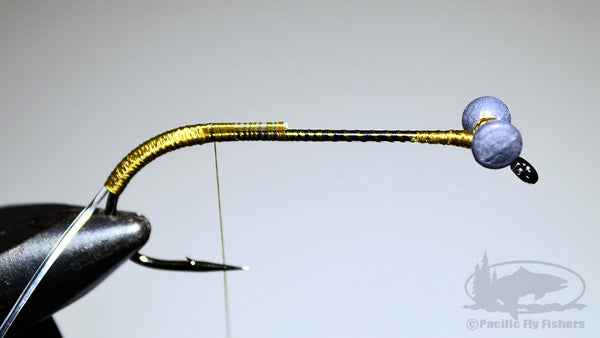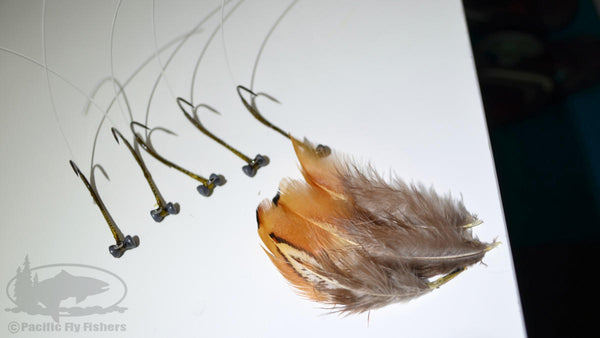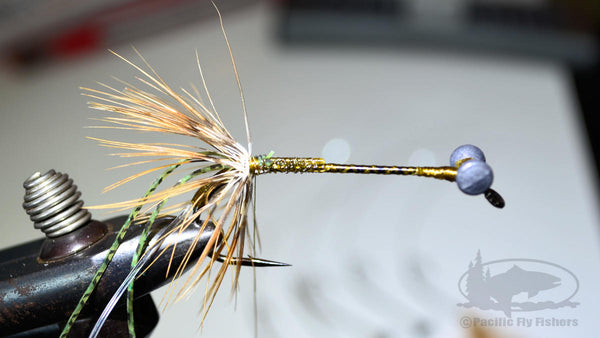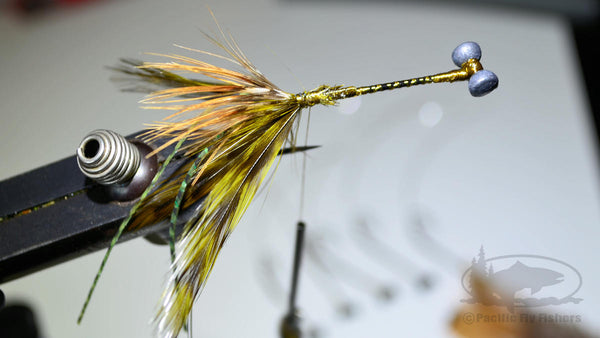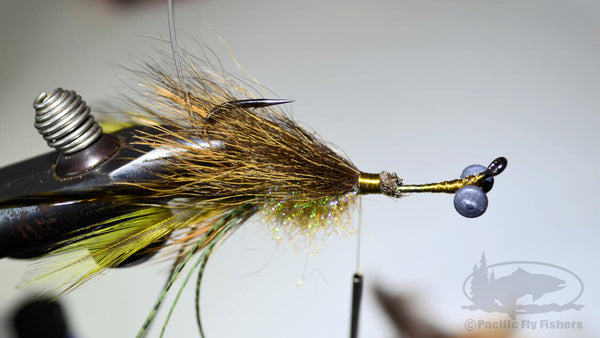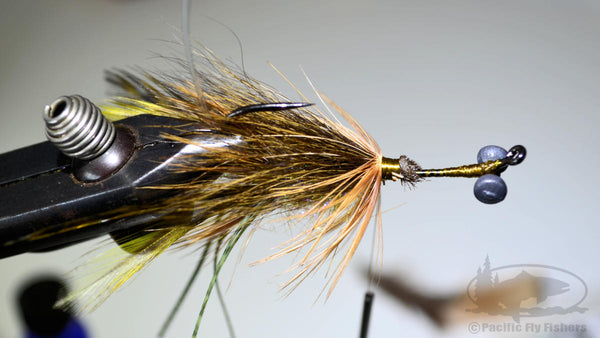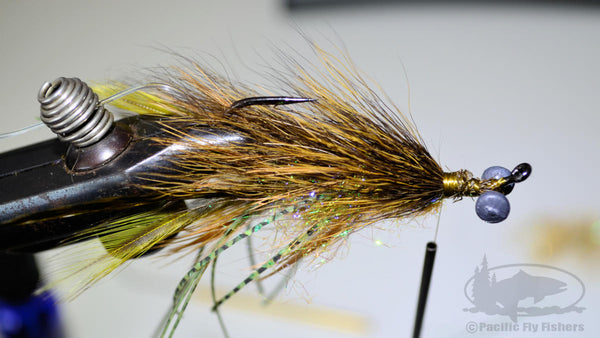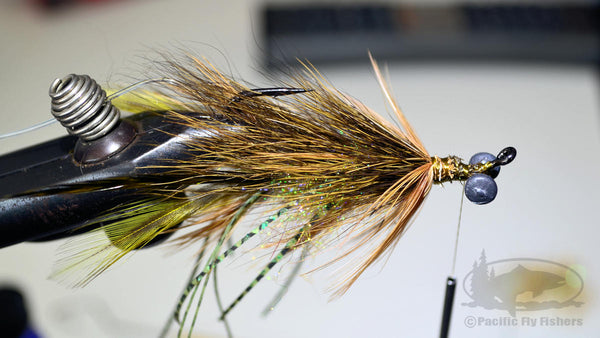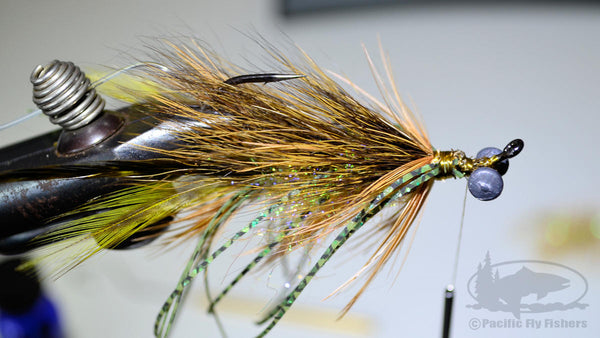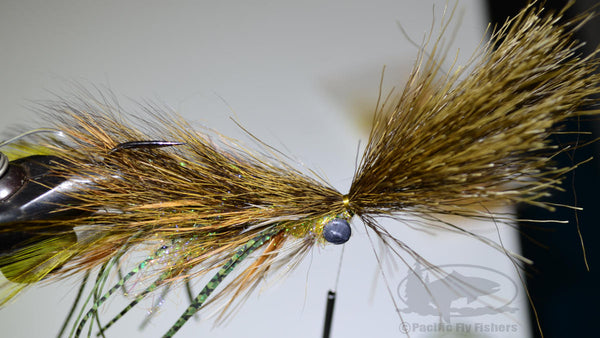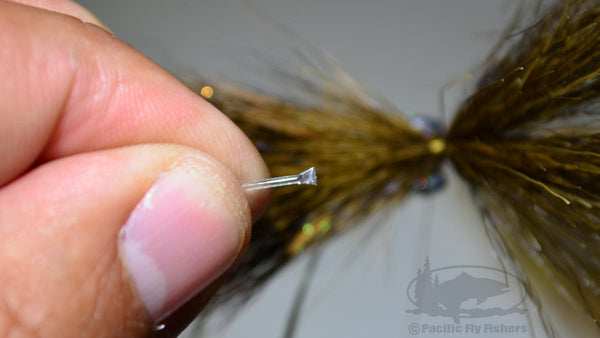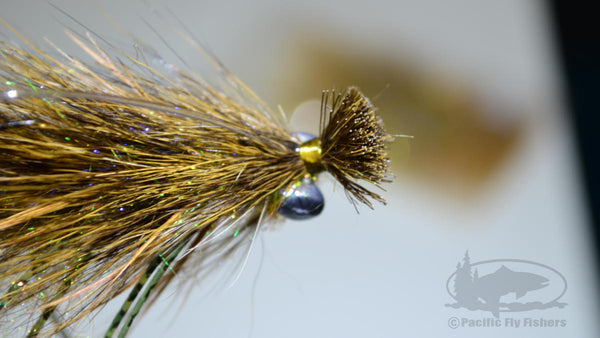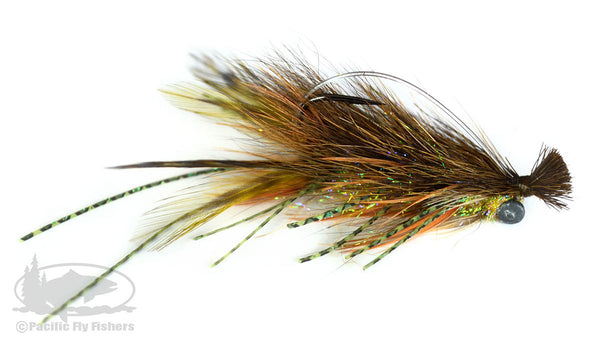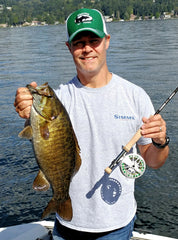 Every fly tier has their own favorite patterns that they lean on throughout much of their fishing time. When I'm looking for smallmouth bass, the Mega Craw has been a standout fly pattern for many years now and I use it a large percentage of the time. I originally designed the Mega Craw from the desire to fish a much larger crayfish fly than what seems to be the norm. I experimented with numerous hooks and tying methods to eventually develop the current version of the Mega Craw shown here. It took a few years and even some underwater video footage to get the Mega Craw to its current state and to get it to swim and bump along the bottom the way I feel is most productive. It also took quite a bit of testing time to find the right fly lines, retrieves and hook setting methods to fish the Mega Craw at the depths where smallmouth often roam. Although I feel there is still much to learn, here is a great fly and some suggestions on how to fish it that I hope will add to your bass fly fishing adventures.
Every fly tier has their own favorite patterns that they lean on throughout much of their fishing time. When I'm looking for smallmouth bass, the Mega Craw has been a standout fly pattern for many years now and I use it a large percentage of the time. I originally designed the Mega Craw from the desire to fish a much larger crayfish fly than what seems to be the norm. I experimented with numerous hooks and tying methods to eventually develop the current version of the Mega Craw shown here. It took a few years and even some underwater video footage to get the Mega Craw to its current state and to get it to swim and bump along the bottom the way I feel is most productive. It also took quite a bit of testing time to find the right fly lines, retrieves and hook setting methods to fish the Mega Craw at the depths where smallmouth often roam. Although I feel there is still much to learn, here is a great fly and some suggestions on how to fish it that I hope will add to your bass fly fishing adventures.
Tying the Mega Craw isn't too difficult but it isn't the fastest fly to tie. The first thing you'll notice is that it is tied on a very large hook compared to most bass fly hooks on the market. For this reason, I began tying on a hook designed for fishing plastic worms but has the gape and wire gauge I was looking for. Although the fly seems large to fly fishing anglers, it certainly isn't large in the "non-fly" bass fishing world. Even a 1-pound smallmouth will make quick work of the Mega Craw without flinching on most days and I feel the larger size of the fly is more likely to entice the larger fish we're all hoping for.
To fish the Mega Craw, look for hard, rocky bottom structure where smallmouth (and largemouth) likely have crayfish on the dinner menu. In the lakes that I most commonly fish, this is typically in 15- to 30-feet of water but I've fished it in as shallow as two feet of water with success. Either way, to fish the Mega Craw, use the fastest sinking lines you can get. My favorite line is RIO's InTouch Striper 30ft Sink Tip Line in the 250-grain size for a 7wt rod and in the 300-grain size for an 8wt rod. The roughly 7-inches per second sink rate gets the fly and line down to the bottom about as fast as possible and at 25+ feet deep, it's nice to get it down as fast as possible. Another reason the Striper line is great for the Mega Craw is that it is casts heavy flies well and, when you're fishing deep, you'll want to chuck it as far as you can on every cast so that the fly spends as much time on the bottom as possible. The no-stretch core to the InTouch Striper line also increases the sensitivity of fish picking up the fly, which is very important.
Use a 12-pound leader around 6-feet in length. The Mega Craw is heavily weighted and a shorter leader makes a world of difference in casting it.
Once you locate a likely fishing spot, make a long cast and let the line and fly sink all the way to the bottom and lay on the rocks. This isn't a normal fly fishing technique but it is the most productive way to fish the Mega Craw without a doubt. When you think the line and fly have reached the bottom, begin your retrieve. You know you're on the bottom and fishing a productive area when you can feel the fly bumping the rocks as you retrieve it. Experiment with retrieve styles but I like long, slow pulls when the water is below 50-degrees and a quick "strip-strip" and then long pull when the water is warmer. Bass will pick up the fly as it is falling so you will either feel a "bump" or just weight on the line when a fish has the fly. If you wait for a yank like a trout, you will miss most fish. When you do feel the bump or something heavy, set the hook with a long, upward sweep of the rod. A strip-set hook set seems like it would be the best approach, but it simply doesn't work as well, and you'll miss a lot of fish that feel the line slowly pulling tight instead of one quick, upward snap of the rod.
Hopefully you're excited to try the Mega Craw and are ready to tie some up. Here are step-by-step instructions on tying it. Shoot us an email if you have questions on tying it or reports from fishing it.
How to Tie the Mega Craw - Olive
Recommended tools: Pliers for cutting heavy mono, Bobbin, scissors, dubbing hook, barb crimping pliers, whip finish tool, bodkin, head cement.
Materials:
- 60lb monofilament
- Gamakatsu Worm Hook - 3/0 - 5/0
- Lead Dumbbell Eyes - Plain - Medium for 3/0. Large for 4/0 and 5/0
- Barred Sili Legs - Olive/Green
- Ringneck Pheasant Skin
- Large Northern Bucktail - Olive
- Whiting Streamer Pack - Grizzly Dark Olive
- ICE Dub - Olive & UV Shrimp Pink
- Not shown in photo -- Ultra Thread 210 Denier - Olive
Step 1: Pinch down the two small barbs on the shank of the hook. These barbs are for holding plastic baits on the hook but only get in the way when using them for fly tying.
Step 2: Use pliers to slightly bend the hook eye toward the hook point. This will ensure the fly always rides correctly in the water and make the fly hop and dance as it is bumped along the rocky bottom.
Step 3: Secure the lead dumbbell eyes to the hook. Position them slightly onto the bent-up portion of the shank to aid in making the fly rest on the bottom with the claws up like a defensive crayfish.
Step 4: Tie in the 60lb monofilament weed guard (optional) at the bend of the hook and cover it with two layers of tying thread. Leave the mono long for now and it will be cut to the proper length later.
Step 5: Apply head cement on the thread that covers the weed guard and on the thread that secures the lead eyes. Set aside to dry. I'll do a few of them to this stage if I'm tying a number of them at once. I also like to begin sorting the Ringneck Pheasant hackles while I wait. Use three large feathers and one smaller feather from the shoulders and flanks of the pheasant skin. (Note: UV curing products like Loon UV Clear Fly Finish - Thin are perfect here and allow you to skip the drying time wait).
Step 6: Add two antenna. I like them about 2.5-inches long.
Step 7: Wrap one of the larger Ringneck Pheasant hackle feathers.
Step 8: Use four grizzly olive hackle feathers from a Whiting Streamer Pack (or similar) to make the claws. Use two feathers on each side. I prefer to make the inside feather a bit shorter than the outside feather for the best appearance of claws. The longer (outside) feather should end up being about the length of the hook total hook length.
Step 9: Add two Sili Legs to each side of the claws. Leave them long. It is easier to trim them to the desired length all at once when the fly is almost finished.
Step 10: Mix together ICE Dub in the colors of Olive and UV Shrimp Pink. Use a 50/50 mixture and blend the two colors together with your hands. Apply a generous amount of dubbing into a dubbing loop and wrap it on the hook shank, ending just short of half way up the shank.
Step 11: From a dyed olive bucktail, take a good portion of hair from the naturally brown, center portion of the bucktail. The hair near the base of the tail is best for the Mega Craw. Flip the hook over in your vise and tie-in the bucktail so that the tips extend beyond the hook bend as shown in the photo.
Step 12: Wrap another larger Ringneck Pheasant hackle over the thread wraps that secure the bucktail. Use your fingernail to push the hackle fibers out to the sides of the fly.
Step 13: Add another pair of Sili Legs to each side of the fly. Keep these long as well so we can trim all the legs in one shot before finishing the fly.
Step 14: Add another section of your ICE Dub mixture using a dubbing loop. Make sure there is still plenty of room between where you end the dubbing and the lead eyes because we still have another section to add after this one.
Step 15: Tie-in a second clump of bucktail. This section of bucktail should extend about halfway over the previous section of bucktail.
Step 16: Yep. You guessed it. Now wrap another large Ringneck Pheasant hackle over the bucktail and push the hackle fibers out to the sides.
Step 17: Add two Sili Legs to each side and keep them long to be trimmed later.
Step 18: Apply more of your ICE Dub mix in a dubbing loop. End your dubbing right up against the dumbbell eyes.
Step 19: Use the smaller Ringneck Pheasant hackle you previously set aside and wrap the hackle right behind the lead dumbbell eyes.
Step 20: Take another clump of bucktail and tie it on in front of the dumbbell eyes. Leave the excess bucktail. We will trim it down in a couple more steps.
Step 21: Cut your monofilament weed guard (if you chose to have one) and cut it to the desired length. Look at the next photo in Step 22 if you aren't sure of the length. Once it is cut to length, use your barb crimping pliers to flatten the end of the monofilament. This will aid in tying it in.
Step 22: Secure the weed guard with very tight thread wraps. Your weed guard should look like the photo.
Step 23: Trim the excess bucktail with a rounded cut to form the crayfish's tail. Then apply head cement to the thread wraps. This will help with the durability of the fly and really helps to keep the weed guard from pulling out after a few fish.
Step 24: Trim the Sili Legs with one cut for each side. I like to angle the scissors so that the front legs (near the dumbbell eyes) are slightly shorter than the back legs (near the claws).
Step 25: Remove the fly from the vise and admire your work!
Summary: I like this olive version in summer once weeds have started to grow on the lakes I fish most often. I also fish a brown/orange version using a dyed orange bucktail, ICE Dub in a 50/50 mixture with the colors of Pheasant Tail and the same UV Shrimp Pink, and Sili Legs in Pumpkin/Green - Orange. This brown/orange version seems to work better in early spring.
When your flies are ready to fish, remember the fishing tips mentioned above...
- Use a 7wt or 8wt rod with a very fast sinking line designed to cast very large flies like the RIO InTouch Striper 30ft Sink Tip or an Airflo 40+ Line.
- Use short, heavy leaders like a 6-foot 12lb RIO Steelhead/Salmon Leader.
- Fish the Mega Craw around rocky structure.
- Let the fly line sink and lay right on the bottom. When you retrieve the fly, let the fly maintain contact with the bottom as much as possible. You should feel the fly bumping rocks as you retrieve the fly.
- Fish the fly with long, slow pulls or a quick "strip-strip" followed by a long pull.
- The bass will almost always hit the fly after a strip when the fly is falling. Set the hook on any bump or any indication of weight on the line.
- Set the hook with a fast and hard upward sweep of the rod.




